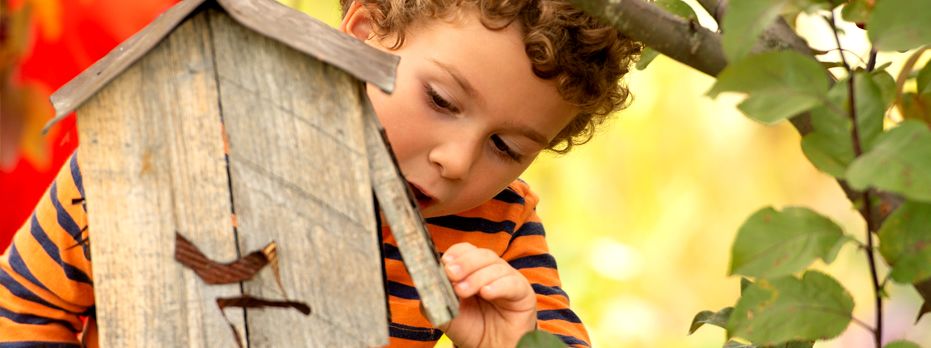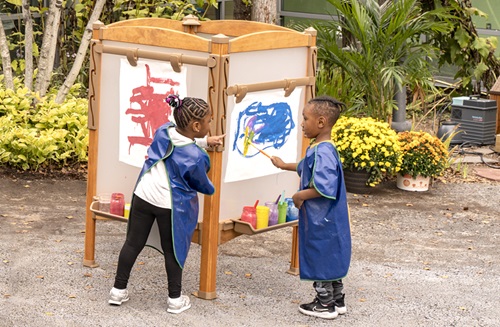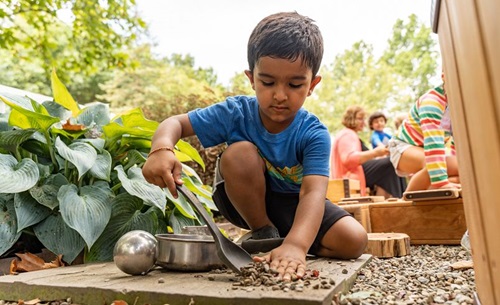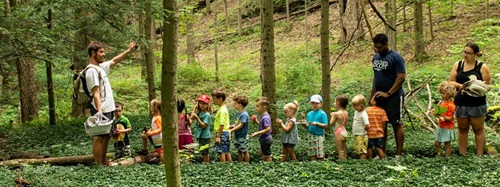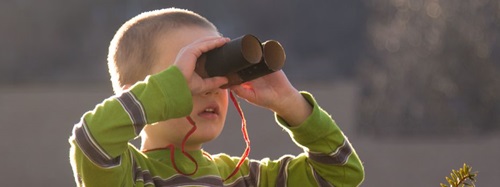Nurturing Environmental Awareness in Children
| November 2008Children of today will inherit a planet that isn't very healthy. We can no longer view our planet's resources as inexhaustible. We must be educated and aware of our impact on its atmosphere, fresh water, soils, forests, and oceans.
There is nothing we can do to change the past; we can only try to create a better and brighter future. It begins with a shift in perspective: it is high time to leave nets and bug jars behind on our nature walks and bring cameras and magnifying glasses along (and maybe a large plastic bag to pick up trash). We can respect that each thing has a place. Each natural thing has a purpose; each bug has a job. Each dried leaf will eventually degrade into nutrient-rich soil to feed the tree from which it fell. Nature wastes nothing. In my class, we say, "It belongs to the earth, not us."
Beginning this process in the early years, when attitudes toward the world around them are forming, is essential. Doing this will help to give young children a new perspective ― a simple idea ― from which they can begin to grow.
What the Teacher can do
There are many lessons around us that can help connect children directly to the wonders of our planet. The teacher's role in creating environmental awareness is to model awe, respect, and wonder. Teachers must show delight with each new discovery and teach respectful observation of the life around us.
It is not required that the teacher have a broad base of knowledge in environmental education, or even a great curriculum. It requires only a shift in perspective coupled with a big dose of enthusiasm and sincerity.
There are many things that we can do to increase opportunities for observation in our classrooms and on our playgrounds. The more things we find to notice, the more children will begin to understand that they are part of a global community, and not the center of one.
One way of helping children learn to be aware of their environment is to ask questions that require opinions and ideas, not facts, such as: Where do you think that insect is going? Have you ever seen one like this before? Isn't the sky beautiful today? Would you like to paint a picture of the sky?
Talking with children is much more effective than talking to them. By involving them in discussions, they focus on what is being said.
It is important that we do not take our surroundings for granted. Taking time to watch the plants, animals, and weather around us is a great way of modeling respect for them. Celebrate the first buds of spring and the last leaf falling in winter. Keep a journal or calendar to record when nature events happen. Record the children's observations as well as your own. This encourages the children to be more tuned in to their environment.
Young children are only aware of their own environments and lives. It's the only reference point they have. Showing them that the world is vast and different everywhere is another way to help them understand that they are only one part of a global community.
Using Globes and Maps
Using globes and maps of the world can easily become part of almost any group time or lesson. When you read a story that comes from or is about a place, find that place on a globe with the group. Talk about and imagine what places may be like ― use National Geographic pictures to help children visualize and begin to understand that the earth has endless variations of landscapes, skin colors, languages, foods, wildlife, and cultures. They are amazed and intrigued to learn that not all children go to school or eat at McDonald's.
Learning the basics about the planet is also easier using a globe to illustrate. The imaginary red line is the equator, which is the warmest place on the earth. Around the equatorial belt is where all rain forest and coral reefs are located. The weather never gets cold there. As one moves toward the poles, the weather gets colder, being coldest at the poles. Three-fourths of our planet is covered by water. Our atmosphere is what makes our planet capable of sustaining life. Using saran wrap around a globe will help illustrate how thin our layer of protection is, and that "outer space" is actually very close.
More Ideas for Observing Nature
Using insects in the classroom is a wonderful way to practice learning to observe respectfully. There are some nature/science stores that sell butterfly kits and ant farms. There is also a company called Insect Lore which you may call at (800) LIVE-BUG. Insect Lore offers a large variety of insects, books, and curricula to go with them.
While hatching and watching the insects' metamorphosis and growth, the children can make books, draw pictures, and keep calendars. Discuss what we see as the changes take place. After you have observed the insects, they can be released, which further illustrates their right to be in their natural environments. Bye bye butterfly!
Hanging feeders or bird houses in yards or outside windows is a wonderful way to attract birds to your area. Providing nesting materials such as shredded newspaper, hay, or straw will draw birds to your yard. Watching them provides endless opportunities for learning about migration, beak types, and species.
Trees and forests are the lungs of our planet. We could not survive without them. Clear cutting of forests is a worldwide problem. Not only does it destroy habitats and oxygen-making trees, but it also loosens soils contributing to mud slides and massive flooding. In and out doors, one can plant almost anything: flowers, vegetables, bulbs, and trees. A curriculum called Project Learning Tree can be obtained through your state's agricultural and forestry department. It is easy to use and very educational for teachers as well. The curriculum, which has all one needs to teach about plants and trees, is cost free after attending a workshop.
Planting a tree each year is important. We have a maple tree that makes wonderful helicopter seeds. We have sent these seeds home with the children on earth day so that they and their parents can plant at home.
On a planet mostly covered by water, it's hard to believe that clean water is becoming scarce. Water conservation is very important. Learning about the earth's water cycle can be fun and easy. Condensation and evaporation make a huge circle. There is neither one more nor one less drop of water in our planet than there was when dinosaurs roamed. It just makes that circle over and over again. As condensation becomes too heavy, it falls in the form of snow, ice, rain, or hail. As it falls, some of it becomes polluted by the dirty air through which it falls; some gets polluted by the dumping of waste in rivers, which dump into oceans. Everything is connected.
Project WET (Water Education for Teachers) is a curriculum available through:
The Water Course
201 Culbertson Hall
Montana State University
Bozeman, Montana 59717-0570
Teaching children about "zoo animals" as a unit is one of my pet peeves. There really is no such thing as a "zoo animal." Zoos are places that have captive wild animals on exhibit for the public to view. They also educate visitors and sometimes breed endangered species. Teaching children that the animals come from all over the world is a giant step towards making a zoo visit educational.
Endangered species are often discussed before a zoo visit. Today, species are disappearing more quickly than ever in history. The main reason for this is loss or pollution of habitat. Protecting habitats is the only way to help endangered species. What is the point of saving them if there is nowhere for them to live?
Project Wild and Aquatic Project Wild are other invaluable resources for educating children and teachers about wildlife. Project Wild may be located through your local wildlife and fisheries department or local fish and game departments.
There are, of course, many ways to reach children and to help them care about the environment. Each teacher and classroom should follow its interests and develop its own ways of knowing and loving this planet of ours. Each young child, exposed to an attitude of wonder and respect toward our planet, will not take for granted the world around them. Protecting our environment will be part of their life work, a legacy they will leave to their children.

